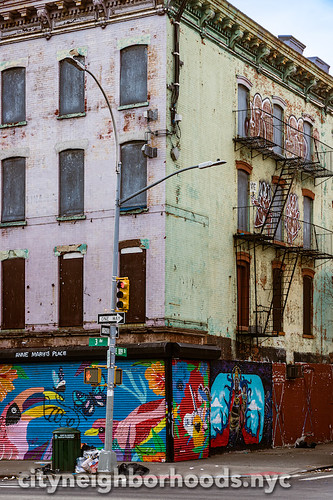Mobile users, you may need to rotate your device or click the + sign above to see the full list of neighborhoods.
Spanish Harlem (El Barrio) - Manhattan - NYC
North of the Upper East Side is the rich, vibrant, working-class neighborhood of Spanish Harlem (nicknamed El Barrio by its predominantly Spanish-speaking residents).
Spanish Harlem (El Barrio) VIDEO
The Neighborhood
North of East 96th Street to East 116th Street, and from Central Park (Fifth Avenue) to the Harlem River, is the neighborhood of Spanish Harlem (El Barrio). This is a neighborhood that is rich with history and culture - and its residents openly celebrate both. From street fairs, booming music, stoop-sitting, street art, and boisterous laughter and conversations, there's a an energy in Spanish Harlem unlike any other enclave in Manhattan.
The neighborhood of Spanish Harlem, also known as El Barrio, is a vibrant and culturally rich area located in the northeastern part of Manhattan. Its name stems from the significant influence of the Hispanic and Latino communities that have shaped its identity and character. Spanish Harlem has a deep history, with roots tracing back to the early 20th century when Puerto Rican migrants began settling in the area. Over time, it has become a vibrant hub for Latin American culture, art, music, and cuisine. The neighborhood is known for its lively atmosphere, colorful murals, and bustling street life. El Museo del Barrio, a renowned museum dedicated to Latin American and Caribbean art, showcases the diverse cultural heritage of the neighborhood and its surrounding communities. Spanish Harlem is also home to iconic music venues, such as the legendary Apollo Theater, where renowned artists like Tito Puente and Celia Cruz have performed. The neighborhood's streets are lined with small businesses, bodegas, and authentic restaurants offering delicious Latin American dishes. Spanish Harlem's strong sense of community, rich cultural traditions, and vibrant energy make it a cherished neighborhood in the heart of Manhattan.
The neighborhood of Spanish Harlem, also known as El Barrio, derived its name from the significant influence and population of Spanish-speaking residents, particularly those of Puerto Rican descent. The area's transformation into a predominantly Latino community began in the early 20th century when Puerto Rican migrants started settling in the neighborhood. As more Puerto Ricans moved to the area, they brought their language, culture, and traditions, creating a vibrant and distinct community. The name "Spanish Harlem" emerged as a way to acknowledge and recognize the cultural heritage and identity of the residents living in the neighborhood. Over the years, El Barrio has become a symbol of Latino pride and resilience, serving as a focal point for preserving and celebrating the rich Hispanic culture and traditions that have shaped the area.
The history of Spanish Harlem, also known as El Barrio, is a tale of resilience, cultural identity, and community empowerment. The neighborhood's story begins in the early 20th century when a wave of Puerto Rican migration to New York City led to a significant influx of residents settling in the area. Seeking better economic opportunities and escaping political turmoil, Puerto Ricans created a vibrant and close-knit community in what would become Spanish Harlem. Over the years, El Barrio faced numerous challenges, including poverty, crime, and urban decay. However, its residents remained resilient, working together to address social issues and advocate for their rights. The Civil Rights and Nuyorican Movements of the 1960s and 1970s brought further recognition to the neighborhood and fueled a sense of cultural pride and activism. Today, Spanish Harlem stands as a testament to the strength and spirit of its community, showcasing a rich blend of Latino heritage, vibrant street life, and artistic expression. The neighborhood continues to evolve, but its history and cultural legacy remain at the heart of its identity.
Spanish Harlem, or El Barrio, is home to several notable landmarks and attractions that showcase the neighborhood's rich cultural heritage. One such landmark is El Museo del Barrio, a renowned museum dedicated to Latin American and Caribbean art. It houses an extensive collection of artworks, artifacts, and exhibitions that highlight the diverse cultural traditions and contributions of the Latino community. Another prominent attraction is the historic Taino Towers, a residential complex that serves as a cultural and community hub. It features a theater, community center, and spaces for events and performances. The neighborhood is also known for its vibrant street art and colorful murals, which can be found throughout the area. Additionally, Spanish Harlem boasts a lively food scene, with numerous authentic Latin American and Caribbean restaurants serving up delicious dishes. The annual Puerto Rican Day Parade, which passes through the neighborhood, is a highlight of the cultural calendar. These landmarks and attractions contribute to the vibrant and unique character of Spanish Harlem, making it a must-visit destination for those seeking an immersive cultural experience.
Spanish Harlem, or El Barrio, has been home to many notable individuals who have made significant contributions to various fields. One such figure is Tito Puente, the legendary Latin jazz musician and composer known as the "King of Mambo." Born and raised in Spanish Harlem, Puente's innovative music and charismatic stage presence brought Latin rhythms to a global audience. Another iconic resident is Julia de Burgos, a renowned Puerto Rican poet and activist. Her powerful verses addressed themes of identity, feminism, and social justice, leaving a lasting impact on the literary world. Piri Thomas, an influential writer and poet, also emerged from Spanish Harlem. His memoir "Down These Mean Streets" chronicled his experiences growing up in the neighborhood, shedding light on issues of race, identity, and urban life. These individuals, among many others, have helped shape the cultural landscape of Spanish Harlem and left a lasting legacy in their respective fields.
Highlight Gallery
Click here for the full Spanish Harlem (El Barrio) photo gallery:
Explore Every New York City Neighborhood:
All photography provided by Samuel Walters


